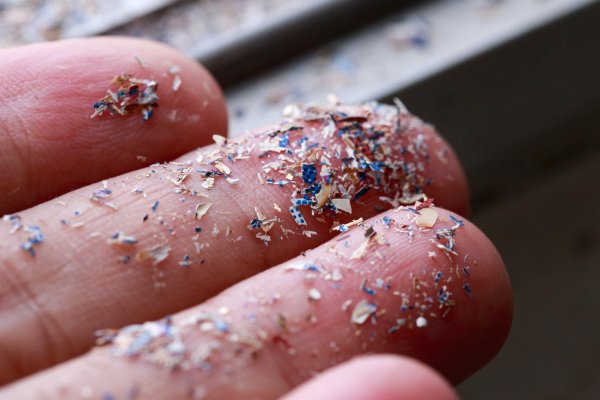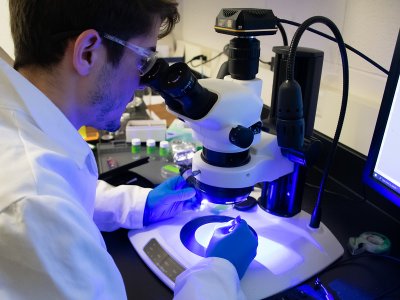Plastic is everywhere. It would be impossible to calculate how many items contain plastic, but it is certainly the majority of products. This includes everything from packaging and electronics to clothing and medical devices. While plastic is an extremely valuable and versatile material, it comes with a downside: Microplastics. These tiny (5 millimeters or less) pieces of plastic have become a significant environmental and human health concern.
Where do microplastics come from?
One source of microplastics is the disintegration of larger plastic debris into smaller pieces, sometimes into particles that are too small to see. Sources can vary widely, but major contributors include synthetic clothing, car tires, city dust, road markings, and marine coatings.
Another source of microplastics comes from manufactured microbeads. Microbeads are commonly used in personal care products due to their abrasive and exfoliating properties. Such examples of products where microbeads are used include scrubbing agents, shower gels, and creams, which can be up to 10% plastic. More recently, microbeads have been reported in agricultural soils and organic fertilizers and have also been intentionally used in asphalt and in building materials to enhance their properties.

How do humans come into contact with microplastics?
There are three ways humans come into contact with microplastics.
First is ingestion. Microplastics can be in the food we eat and the liquids we drink. It can get into food and drinks from the plastic packaging it is in. Microplastics can also be absorbed by crops that are grown using soil or fertilizers that have microplastics in them. Cooking with plastic utensils and non-stick cookware can also contaminate food.
Next is inhalation. Because microplastics can break down to such small sizes, they are able to be lifted and transported by the air. Sources can be dust from urban areas, solid waste application to agricultural fields, emissions from vehicles and braking, landfill erosion, and spray from the ocean.

A third way microplastics can enter the body is through skin contact. While the skin protects the body from foreign objects entering the body, there is developing research that is investigating how microplastics can enter the body through hair follicles, sweat glands, and even small cuts. There is also concern over chemicals in microplastics leaching into the body, such as Bisphenol A (BPA), and flame retardants, such as PFAS.
What are the health risks associated with microplastics?
While researchers are examining the impacts of microplastics on human health, there is limited evidence to indicate that microplastics are causing serious health problems.
However, microplastics have been found throughout the human body, including in the blood, saliva, liver, kidneys, lungs, and placenta. And there are concerns about how microplastics are affecting humans.
Microplastics in the blood vessels have raised concerns, which include increased risk of heart attack, strokes, inflammation, and blood clotting. The chemicals in microplastics have been linked to various health issues, including cancer, immune system damage, reproductive problems, and developmental delays.
In the video: Not only may microplastics pose risks to human health, but Penn State researchers have found that they may also influence weather and climate by promoting cloud formation in conditions where clouds might not typically develop.
How can I reduce my exposure to microplastics?
Microplastics are emerging pollutants, posing significant challenges for individuals, communities, and governments. However, there are actionable steps that can be taken to reduce exposure.
First, you can opt for reusable products over single-use plastics. Second, choose natural fibers over synthetic. Use water filters to capture microfibers, and drink tap water instead of bottled water, which can contain higher levels of microplastics. Properly dispose of plastic waste to prevent it from breaking down into microplastics.
At the community level, governments can enforce regulations to reduce plastic production and waste. Tackling plastic pollution requires raising awareness and creating evidence-based policies with input from scientists, communities, and stakeholders. Public education, research, and collaboration are key to reducing microplastics and ensuring effective, transparent solutions.

As production continues to rise, so does plastic waste, contributing to the widespread presence of microplastics in oceans, freshwater systems, soil, and even the air we breathe.
Challenges and opportunities
For the environment, scientists are developing better methods for detecting, quantifying, and characterizing microplastics in different environmental media. Two interesting areas of ongoing research are innovative control methods and exploring bioplastics as a potential substitute for traditional plastics
Our understanding of microplastics is growing, but so are the challenges. Right now, there aren’t standardized methods for identifying and measuring microplastics, making it hard to compare study results. Another challenge is the limited access to specialized equipment needed for microscopic analysis.
At Penn State, the Environmental Contaminants Analytical Laboratory has equipment that can identify and quantify microplastics in wide variety of materials, including soil and sediments, fresh and marine water samples, animal tissues, and medical saline water. Our team has specialized expertise with Laser Direct Infrared chemical imaging system (LDIR), SurveyIR and Visual microscopy, pyrolysis-GC/MS, thermal desorption-gas chromatography-mass spectrometry, and High-Resolution Time-of-Flight Aerosol Mass Spectrometer. We have helped clients with projects such as:
- Occurrence, distribution, fate, and ecological impacts of microplastics in freshwater systems
- Microplastics in soil, sediments, fish, and clams
- Detection of nanoplastics in air
- Microplastics leaching from asphalt
- Nanoplastics in medical saline water
- Fate and transport of nanoplastics in organs such as mice brain tissue
- Understanding lower size limits of microplastics and challenges in detecting them in complex samples
As the world grapples with increasing plastic pollution, microplastics remain a pressing concern for both human health and the environment. While researchers and governments work to better understand and mitigate these risks, individuals can play a role by making small, thoughtful changes in daily life. Together, through science, policy, and action, we can move toward a future where the harmful impacts of microplastics are minimized, ensuring a cleaner and healthier world for generations to come.
Hlengilizwe Nyoni is an assistant research professor who oversees and is the lead researcher in the Environmental Contaminants Analytical Laboratory. He is an expert analytical chemist with a unique ability to interpret and understand the rationale behind models, theories, and principles of diverse mass spectroscopy techniques. He has a deep knowledge in vast analytical techniques including high resolution mass spectrometer (UHPLC-Orbitrap) and tandem mass spectrometer (GC-QQQ) amongst others.
This blog post was written/edited in collaboration with Kevin Sliman.





